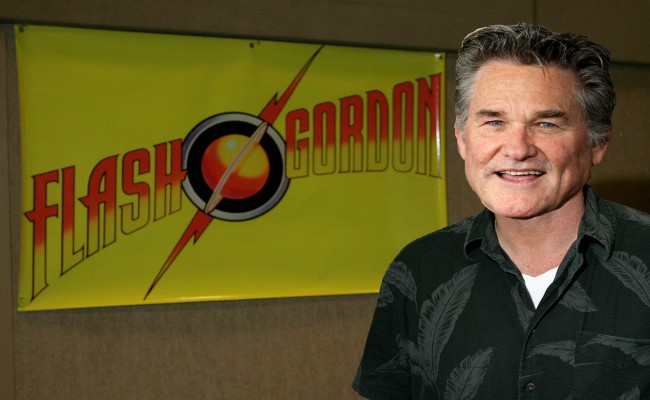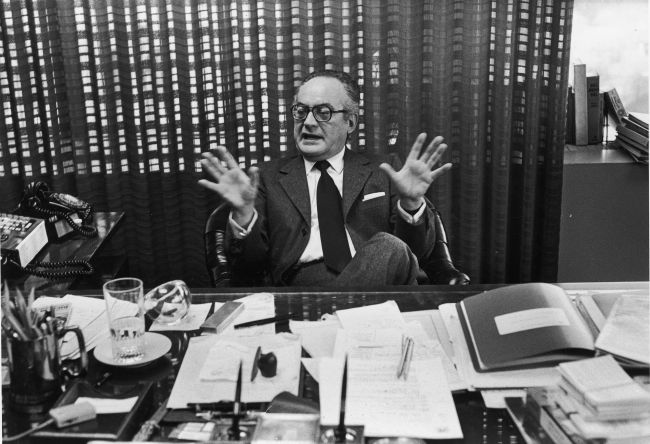Thirty-five years ago, a blonde football star embarked on a space adventure to save the world, and – thanks in part to a talking bear – it’s a journey we’ll never forget.
Flash Gordon, Mike Hodges’ 1980 operatic film based on the comic strip of the same name, paired together utterly ridiculous sets and costumes with unintentionally hilarious dialogue for the perfect campy masterpiece. Highly regarded by critics and fans alike, the Sam Jones-starring cult classic came with an infectious soundtrack by Queen and went on to inspire some other cinema greats.
While an initial sequel never came to fruition (you’ll find out why below), it seems as though Flash is finally headed back to the movie theatre – and not a moment too soon. While we wait for Twentieth Century Fox to cast a star for their anticipated reboot, here’s some behind-the-scene tidbits you might not have known about the man who saved every one of us.
Producer Dino De Laurentiis wanted Kurt Russell for Flash.

Kurt Russell might have been the savior of the universe if the studio had their way. The film’s producer, the late and legendary Dino De Laurentiis, apparently wanted the then-young and studly Russell to star as Flash. Russell, unfortunately, wasn’t interested in the role – he felt the character was too one-dimensional.
One actor who did want the part? The governator! Arnold Schwarzenegger, despite having the character’s physicality, was denied the role due to his thick Austrian accent.
Sam Jones got the role of Flash after appearing on The Dating Game.
So where does one turn when their dream star turns down the lead role? To The Dating Game, of course!
Sam Jones appeared on the classic dating game show in the late seventies, and a member of De Laurentiis’ family just happened to be watching.
“They called me in the meeting with Dino De Laurentiis. It was a long process from the time I first met him,” Jones told Den of Geek. “It could have been almost nine months to a year the entire process. I found out later his mother-in-law was watching a TV game show called The Dating Game which I went on. I lost the date, but Dino’s mother-in-law saw that episode and said ‘Dino, I think that’s your Flash Gordon right there!’ ”
While Jones contended that you could “just Google” his appearance, we, unfortunately, had no luck tracking it down.
De Laurentiis didn’t intend for the movie to be campy.

While Flash has been praised for its perfect camp and take on the fifties and sixties’ live action comic book shows, the cast said the film’s comedy wasn’t on purpose. In fact, De Laurentiis intended for a very serious, straight-forward adaptation and was upset when people laughed during screenings.
Melody Anderson (Dale) said that she took her role “very seriously” and that the cast played the dialogue “straight.”
“When the crew watched the rushes and were laughing hysterically, Dino said, ‘Why are you laughing?’ And then they discovered they had a comedy, that it was camp,” Anderson said in an interview after the film’s release. “I’ve heard from the screenings that some people couldn’t hear the words because of all the applause and laughter… but we did play it seriously.”
She added that they “weren’t out to make a funny film” and De Laurentiis thought people were laughing at it and not with it.
George Lucas couldn’t get the rights to Flash Gordon … so he made Star Wars.
A long myth that has real roots: George Lucas couldn’t make the big screen version of Flash, so instead, he made Star Wars. And we all know how that worked out.
According to a Mashable interview with Star Wars and The Empire Strikes Back producer Gary Kurtz, he and Lucas couldn’t adhere to the “draconian” restrictions King Features attached to the rights. Instead, they conceptualized something with the “energy of the Flash Gordon,” a “Buck Rogers style of space opera.” He added, “we did discuss Flash Gordon-type stories at great lengths.”
De Laurentiis probably wished Lucas would have stuck around – he went through a long process and burned through a few director options before hiring Mike Hodges.
Jones left the movie before post-production so “half of the film” dialogue had to be dubbed.
Jones couldn’t get along with De Laurentiis, so he simply left set – before the film was finished. In fact, he left so early that, according to the actor, himself, the majority of his lines were dubbed over by a still-unidentified voice actor.
“Producer Dino De Laurentiis and I bumped heads a few times – there were a few misunderstandings,” Jones told Maxim in 2012. “In my naivety at the age of 25 I just let the attorneys handle everything – I just let my representation handle it and they did not do a very good job at all.”
He didn’t return for lopping and dubbing, and, ultimately, squashed any chance of a sequel (until now!).
Mike Hodges didn’t want Queen to do the soundtrack and De Laurentiis had never even heard of them.
It’s hard to imagine that anyone could not know of Freddie Mercury’s incomparable vocal prowess, but apparently, that was the case when it came to enlisting a band for the Flash soundtrack.
While Hodges simply wanted a different sound (Pink Floyd‘s, to be exact), De Laurentiis had no idea who the iconic rock band Queen was.
The band was approached for the gig in 1979 and they were immediately interested in the prospect of working on a film, according to Queen’s website. Their manager arranged a meeting with De Laurentiis to discuss the opportunity and he allegedly asked “who are the Queens?”
The movie’s art director never read the script.
Imagine creating the sets for a feature film but not knowing anything about the plot. Now, add a language barrier.
De Laurentiis hired Italian art director Danilo Donati for Flash, who opted to work on the entire production without ever reading the script, according to screenwriter Lorenzo Semple. Semple said that while Donati’s designs were “fantastic,” it had “nothing to do with the story, and would actually be un-shootable.”
“For instance, he spent $1 million on the Arboria set, which was used in one shot,” Semple revealed. “It was really disorganization carried to the ultimate degree.”
Semple added that he butted heads with De Laurentiis because he complained to often that Danilo was “running the picture.”
The language barrier on set was extreme.
About that language barrier – it affected more than just the set design. De Laurentiis hired a mostly Italian crew, leading to discord with the American and UK actors and crew members.
“The English thought they knew, and the Italians thought they knew, and the actors were caught in the middle of all this confusion of, ‘What’s going on?’ It was, well – an interesting four and a half months,” Anderson revealed.
Hodges resented the dissonance, so instead he shot “whatever he wanted” – regardless of the sets. The Italian crew didn’t know enough English to even let De Laurentiis know the film was going in a different direction, and thus, the aforementioned clash between camp and serious occurred.






